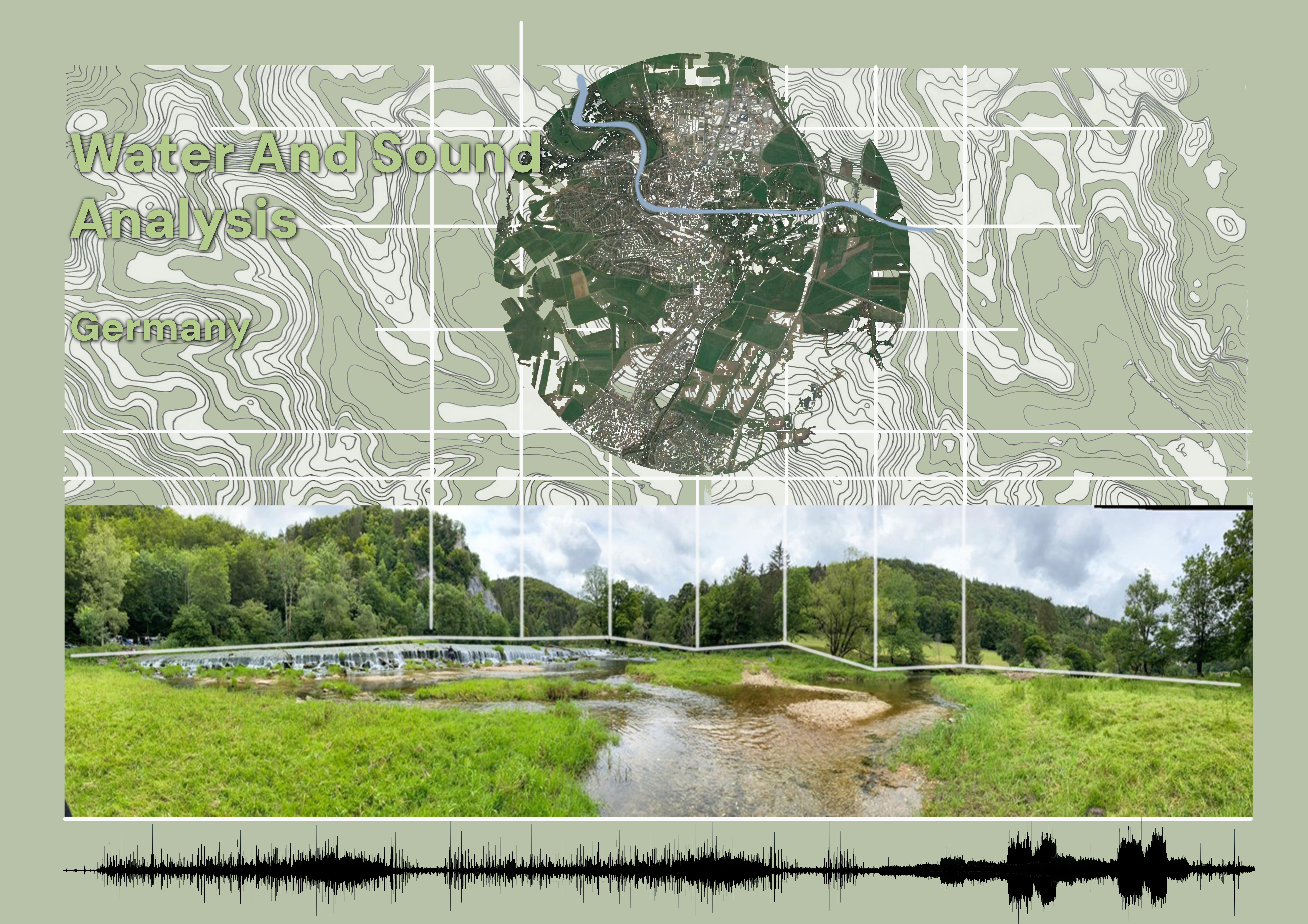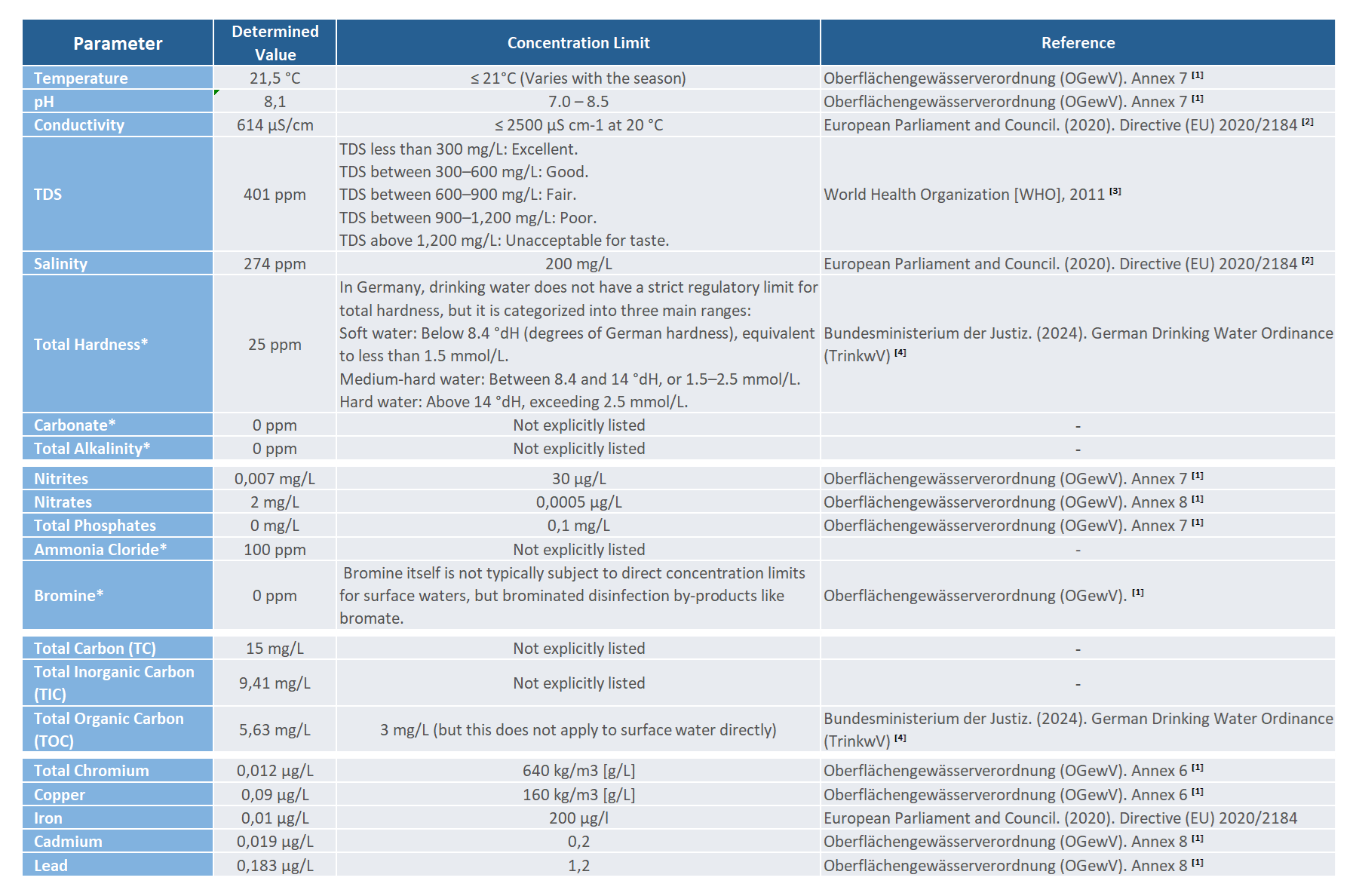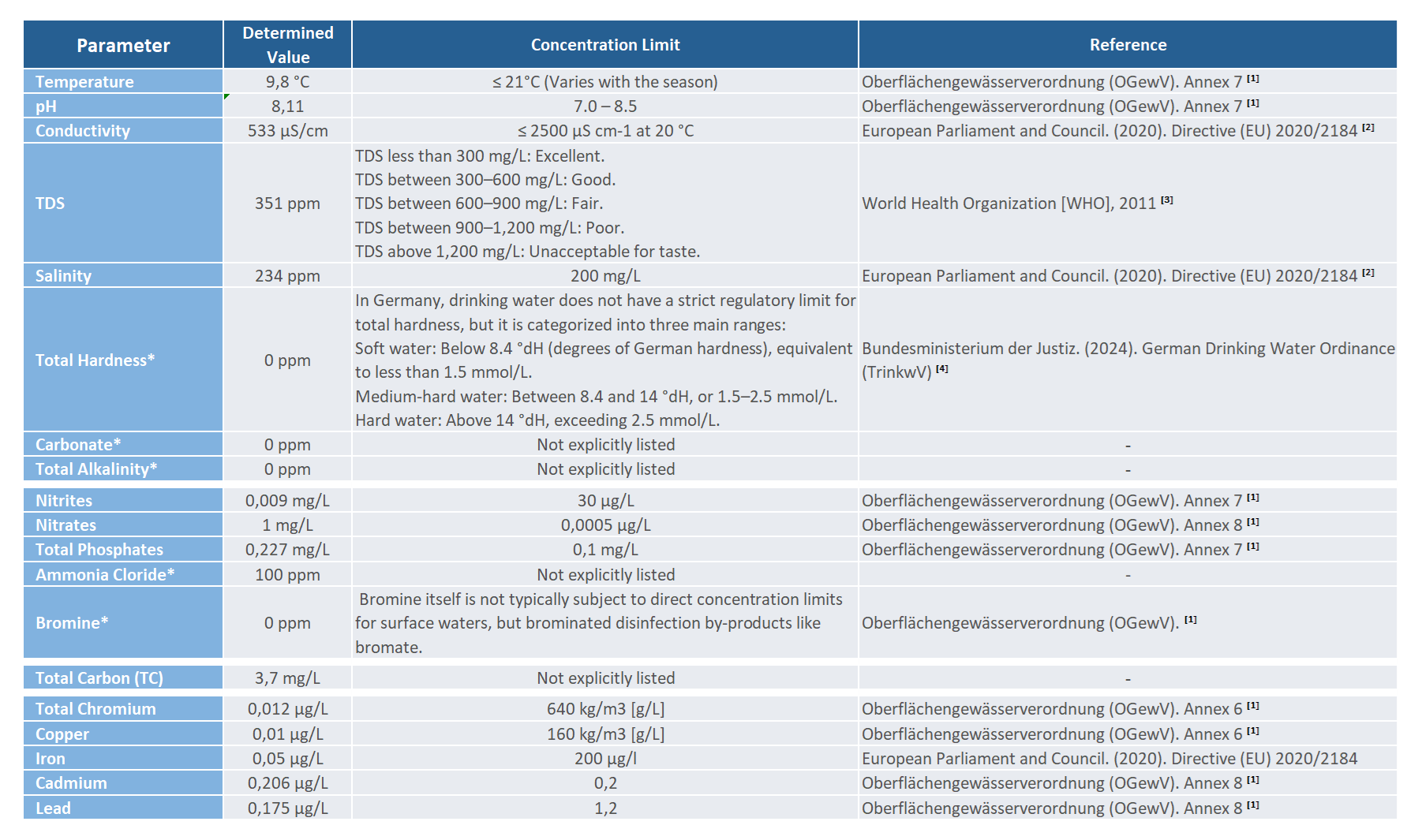Sound and Water Analysis
Jägerhaus, Fridingen, Germany

Sound Analysis
Date and time
03/07/2024
10.00 am
Atmospheric Situation A Softly Dampened Atmosphere
Step into a gently overcast day, where the skies are slightly cloudy and a light rain adds a refreshing touch to the air. The mood is calm and quiet, perfect for those seeking a peaceful pause:
- Mild Cloud Cover: The sky is gently veiled with soft clouds, diffusing the light for a cool, serene ambiance.
- Light Drizzle: A subtle rain falls, adding a gentle, rhythmic patter that enhances the tranquil atmosphere.
- Stillness in the Air: With barely a breeze, the quiet is uninterrupted, offering a soothing and reflective environment.
Ambient sounds
Water Analysis
Sample Point 1

The water sample from the Danube River at the Jägerhaus – J1.3 sampling point in Germany was analyzed considering various regulations to assess its quality. The main regulatory frameworks used for this evaluation include the Oberflächengewässerverordnung (OGewV), which sets specific limits for surface water quality in Germany, the European Parliament and Council’s Directive (EU) 2020/2184), which provides guidelines for drinking water, and the World Health Organization (WHO) 2011 guidelines for total dissolved solids (TDS). Additionally, the German Drinking Water Ordinance (TrinkwV) from 2024 was consulted, which categorizes total hardness in drinking water. Since the German law does not explicitly cover some of the analyzed parameters (such as total organic carbon and salinity), international guidelines from the WHO and the European Union were referenced to ensure a more comprehensive assessment.
Several water quality parameters at Jägerhaus – J1.3 were found to meet the established regulatory limits. The temperature of 21.5°C is at the upper boundary of the OGewV threshold for seasonal variation, which is acceptable. The pH level of 8.1 is within the acceptable range of 7.0 – 8.5 according to OGewV, ensuring no adverse effects on aquatic life. Conductivity at 614 µS/cm falls well below the European limit of 2500 µS/cm, signifying a low presence of ionic pollutants. The TDS concentration of 401 ppm is categorized as „Good“ by WHO, indicating favorable water quality. Nitrites, nitrates, and total phosphates were all within the acceptable regulatory limits, suggesting minimal nutrient pollution, which is crucial for maintaining aquatic ecosystems. Heavy metals like total chromium, copper, and iron were also below the limit values, ensuring compliance with the relevant regulations for environmental protection.
However, some parameters raised concerns as they could potentially exceed regulatory limits or pose risks to human health and the environment. The TDS concentration, while within the „Good“ category, could still affect water taste and its suitability for consumption if concentrations rise. Additionally, salinity at 274 ppm exceeds the EU threshold of 200 mg/L, which could affect the water’s palatability and impact freshwater ecosystems. Furthermore, the concentration of total organic carbon (TOC) at 5.63 mg/L is higher than the guideline of 3 mg/L, which could lead to oxygen depletion in the water, negatively affecting aquatic organisms. The presence of cadmium (0.019 µg/L) and lead (0.183 µg/L) is concerning, as these metals exceed the respective thresholds and pose toxicity risks to aquatic life and human health through bioaccumulation. Monitoring and mitigating these parameters are critical to maintaining both environmental integrity and public health.
Sample Point 2

The surface water sample from the Danube River at the Jägerhaus – J2.2 sampling point in Germany was analyzed in accordance with several regulatory frameworks to assess its water quality. The primary regulations referenced include the Oberflächengewässerverordnung (OGewV), which sets specific limits for surface water quality in Germany, and the European Parliament and Council’s Directive (EU) 2020/2184), which provides guidelines for drinking water quality, including conductivity, TDS, and salinity limits. In addition, the World Health Organization (WHO) guidelines for total dissolved solids (TDS) were consulted for taste-related thresholds, and the German Drinking Water Ordinance (TrinkwV) was used for drinking water quality standards, particularly for hardness and metals. Since the German surface water regulations do not explicitly cover some parameters like total carbon and salinity, other international guidelines were used for a more complete evaluation.
The analysis revealed that several parameters met the regulatory standards. The temperature of 9.8°C is well within the seasonal threshold of ≤21°C, indicating acceptable conditions for aquatic life. The pH value of 8.11 is also within the permissible range of 7.0 – 8.5 according to OGewV, indicating neutral to slightly alkaline water, which is suitable for most freshwater ecosystems. Conductivity at 533 µS/cm is far below the European limit of 2500 µS/cm, suggesting low ionic contamination. The TDS level of 351 ppm falls within the „Good“ range according to WHO guidelines, ensuring the water is not excessively saline. Nitrites, nitrates, and phosphates were found at levels that comply with the regulatory limits, indicating a minimal nutrient load in the water, which is beneficial for maintaining the aquatic environment.
However, several parameters raised concerns as they either exceeded regulatory thresholds or could pose risks to water quality. The nitrate concentration of 1 mg/L surpasses the stringent limit of 0.0005 µg/L outlined in the OGewV, suggesting possible agricultural runoff or pollution. Similarly, total phosphates at 0.227 mg/L exceed the limit of 0.1 mg/L, which could contribute to eutrophication, leading to excessive algae growth and oxygen depletion in the water. The total carbon concentration of 3.7 mg/L, while not directly regulated, could result in increased biochemical oxygen demand (BOD), affecting the water’s ability to support aquatic life. Heavy metals such as cadmium (0.206 µg/L) and lead (0.175 µg/L) also exceeded the limits for surface water, raising concerns about their toxicity to aquatic organisms and potential bioaccumulation in the food chain. The presence of these pollutants could have long-term detrimental effects on both the local ecosystem and public health, necessitating further monitoring and possible mitigation measures.
References:
[1] Federal Ministry of Justice and Consumer Protection. (2016). Oberflächengewässerverordnung (OGewV) [Surface water ordinance]. https://www.gesetze-im-internet.de/ogewv_2016/index.html#BJNR137310016BJNE002400000
[2] European Parliament and Council. (2020). Directive (EU) 2020/2184 of the European Parliament and of the Council of 16 December 2020 on the quality of water intended for human consumption. https://eur-lex.europa.eu/legal-content/EN/TXT/?uri=CELEX%3A32020L2184
[3] World Health Organization. (2011). Guidelines for drinking-water quality: Fourth edition, incorporating the first addendum. https://www.who.int/water_sanitation_health/publications/2011/dwq_guidelines/en/
[4] Bundesministerium der Justiz. (2024). Trinkwasserverordnung (TrinkwV) [Drinking water ordinance]. https://www.gesetze-im-internet.de/trinkwv_2001/
